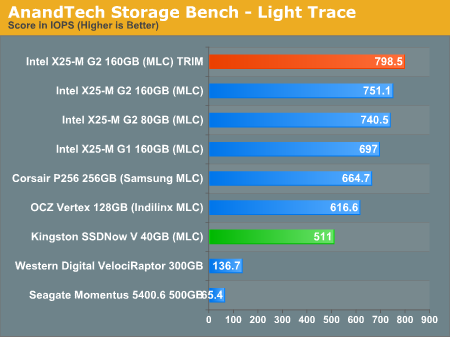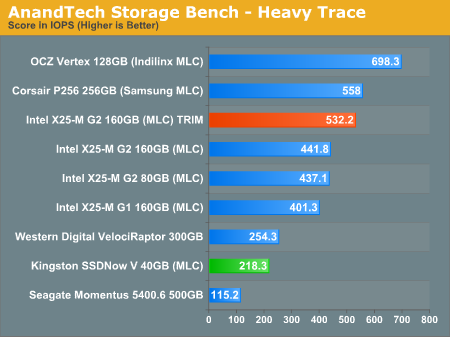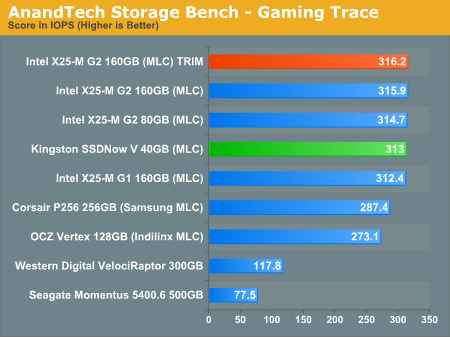The SSD Improv: Intel & Indilinx get TRIM, Kingston Brings Intel Down to $115
by Anand Lal Shimpi on November 17, 2009 7:00 PM EST- Posted in
- Storage
Introducing the AnandTech Storage Bench - Real World Performance Testing
Finding good, real world, storage benchmarks is next to impossible. The synthetic tests work up to a certain point but you need real world examples. Measuring performance in individual applications often ends up with charts like these where all of the drives perform identically. Benchmark suites like PCMark Vantage are the best we can do, but they are a bit too easy on these drives in my opinion and while representative of a real world environment, they aren’t necessarily representative of all real world environments.
Recently we’ve been able to get our hands on a piece of software that allows us to record all disk activity on a machine and then play it back on any other machine. The point is that we can now model a real world usage scenario without waiting for BAPCo or Futuremark to do it for us.
Our benchmarks debut here, today, and we’re starting with three. We haven’t had time to run all of the SSDs through this new suite so we’ll start with an abridged list.
The first in our new benchmark suite is a light usage case. The Windows 7 system is loaded with Firefox, Office 2007 and Adobe Reader among other applications. With Firefox we browse web pages like Facebook, AnandTech, Digg and other sites. Outlook is also running and we use it to check emails, create and send a message with a PDF attachment. Adobe Reader is used to view some PDFs. Excel 2007 is used to create a spreadsheet, graphs and save the document. The same goes for Word 2007. We open and step through a presentation in PowerPoint 2007 received as an email attachment before saving it to the desktop. Finally we watch a bit of a Firefly episode in Windows Media Player 11.
There’s some level of multitasking going on here but it’s not unreasonable by any means. Generally the application tasks proceed linearly, with the exception of things like web browsing which may happen in between one of the other tasks.
The recording is played back on all of our drives here today. Remember that we’re isolating disk performance, all we’re doing is playing back every single disk access that happened in that ~5 minute period of usage. The light trace is composed of 37,501 reads and 20,268 writes. Over 30% of the IOs are 4KB, 11% are 16KB, 22% are 32KB and approximately 13% are 64KB in size. Less than 30% of the operations are absolutely sequential in nature. Average queue depth is 6.09 IOs.
The performance results are reported in I/O Operations per Second (IOPS):

The hard drives set the minimum level of expectations here, the VelociRaptor only manages 137 IOPS. The fastest SSD is the X25-M G2 with the TRIM firmware installed at nearly 800 IOPS. The improvement over the older firmware is 6.25% thanks to the higher sequential write speed. The G2 is a bit faster than the G1 here, but what’s most interesting is how well the competing SSDs do.
Corsair’s P256 based on the Samsung RBX controller is very close to the performance of Intel’s X25-M G1 at 664 IOPS. It even outperforms the Indilinx MLC based OCZ Vertex by around 8%.
The Kingston 40GB drive is hampered by its small amount of free space. The actual benchmark takes up around 33GB of space, leaving very little breathing room for the baby SSD. That being said, the hopefully $85 bugger is nearly 4x the speed of a VelociRaptor.
If there’s a light usage case there’s bound to be a heavy one. In this test we have Microsoft Security Essentials running in the background with real time virus scanning enabled. We also perform a quick scan in the middle of the test. Firefox, Outlook, Excel, Word and Powerpoint are all used the same as they were in the light test. We add Photoshop CS4 to the mix, opening a bunch of 12MP images, editing them, then saving them as highly compressed JPGs for web publishing. Windows 7’s picture viewer is used to view a bunch of pictures on the hard drive. We use 7-zip to create and extract .7z archives. Downloading is also prominently featured in our heavy test; we download large files from the Internet during portions of the benchmark, as well as use uTorrent to grab a couple of torrents. Some of the applications in use are installed during the benchmark, Windows updates are also installed. Towards the end of the test we launch World of Warcraft, play for a few minutes, then delete the folder. This test also takes into account all of the disk accesses that happen while the OS is booting.
The benchmark is 22 minutes long and it consists of 128,895 read operations and 72,411 write operations. Roughly 44% of all IOs were sequential. Approximately 30% of all accesses were 4KB in size, 12% were 16KB in size, 14% were 32KB and 20% were 64KB. Average queue depth was 3.59.

While I appreciate that Intel improved sequential write speed a bit in the 160GB G2 drives, the heavy trace results show us that it’s not enough. The improvement to the 160GB G2 is tremendous, over 20%. But that only brings the 160GB G2 up to the performance of the Corsair P256 (Samsung RBX). The real winner here is the Indilinx based OCZ Vertex. At nearly 700 IOPS it has the right balance of random and sequential read/write speed for our heavy usage scenario. To quote from the Relapse:
“When I started writing this article I took a big step. I felt that Indilinx drives had reached the point that their performance was good enough to be considered an Intel alternative. I backed up my X25-M, pulled it out, and swapped in an OCZ Vertex drive - into my personal work system. I've been using it ever since and I must admit, I am happy. Indilinx has done it, these drives are fast, reliable (provided that you don't upgrade to the latest firmware without waiting a while) and are good enough.”
This is more than good enough, this is faster than Intel.
Unfortunately Intel has assured me that there’s no additional write speed left on the table for the X25-M G2. We’ll have to wait for the G3 next year to see that addressed.
Kingston’s very low sequential write speed hurts it the most here, the drive actually delivers performance lower than that of a VelociRaptor (although not by much). To be honest, this is a bit of an unfair test for the 40GB drive. It’s far too intense for what would ultimately be an apps/OS drive, but it does highlight the 40GB drive's weakpoints.
Our final test focuses on actual gameplay in four 3D games: World of Warcraft, Batman: Arkham Asylum, FarCry 2 and Risen, in that order. The games are launched and played, altogether for a total of just under 30 minutes. The benchmark measures game load time, level load time, disk accesses from save games and normal data streaming during gameplay.
The gaming trace is made up of 75,206 read operations and only 4,592 write operations. Only 20% of the accesses are 4KB in size, nearly 40% are 64KB and 20% are 32KB. A whopping 69% of the IOs are sequential, meaning this is predominantly a sequential read benchmark. The average queue depth is 7.76 IOs.

The gaming test is almost entirely reads and thus the Intel drives have no weaknesses. The G2s, G1s, TRIM or not, all perform about the same here. They’re about 10% faster than Samsung and 15% faster than Indilinx. Even the 40GB Kingston does just as well here.










162 Comments
View All Comments
Celeus - Monday, November 9, 2009 - link
No comment regarding Anand, but the quote of $85 seems to be based on a press release from kingston.http://www.kingston.com/press/2009/flash/10c.asp">http://www.kingston.com/press/2009/flash/10c.asp
Now, I've been trying to find these for that price at Newegg, and can't. The drive now shows up (just the 2.5" one, not the one including the bracket) but for $124.99 before rebate $104.99 AR.
I bet this is an error they will fix, as $104.99 Before Rebate would make $84.99 AR, which is what Kingston mentions in their press release.
Rebate looks good for 2 per person, so I plan on buying two for a new Windows 7 box.
virtualgeek - Saturday, October 31, 2009 - link
Disclosure, I work for EMC (an enterprise information infrastructure - which includes all sorts of storage arrays).Looking at some of the comments, I'm not sure if people understand the impact of the x-25 getting down to the prices they are (both via kingston OEM and the 80/160GB drives).
Flash will rapidly replace all high-performance disk use cases. There will only be room for very large SATA and SAS disks, and all high performance use cases will be dominated by Flash.
Some people don't understand that even at TODAY's prices, for some (many) use cases (just not consumer focused ones), they are more economical. For example, the kingston drive, measured in IOPs/dollar is 37x **cheaper** than a 15K SAS drive. That's the acquisition cost. When you think that it would take 37 15K SAS disks, consuming more power, space and cooling - you can immediately imagine the impact this has on the enterprise storage market.
The rapid price decline we've all seen over the last year (a 40GB MLC drive cost ~$900 at the beginning of the year) means that in the next year or so, we'll have SSD with the $/GB of a large, fast rotating magnetic media disk, but still 100x better random IOps/$
While perhaps PCM non-volatile storage will eventually replace flash, that will happen well after flash replaces spinning media.
Great article Anand!
I did a post on it here...
http://virtualgeek.typepad.com/virtual_geek/2009/1...">http://virtualgeek.typepad.com/virtual_...ill-chan...
iwodo - Friday, October 30, 2009 - link
If V Series stays at $85, then making a Raid with 2 40GB V will be an VERY attractive option.So may be do a review on 2 40GB V series with Intel Software Raid? as well as other raid card?
excalibur3 - Thursday, October 29, 2009 - link
Thanks for the great article! I am just curious if the Kingston UltraDrives can use the same firmware update as intel and can be considered the same drive or if it is something like with OCZ and Super Talent in that they have separate firmware updates. Would the Kinston be a cheaper alternative to the Intel?Saturn1 - Thursday, October 29, 2009 - link
Is there a way to get the manual trim to run from the toolbox if you do not have that last firmware update?linster - Thursday, October 29, 2009 - link
Apparently Intel pulled the iso. Here's what you get after you click on the link,"02HA Firmware Upgrade for Windows 7* Systems - Unavailable
Intel has been contacted by users with issues with the 02HA firmware upgrade on Windows 7* systems and are investigating. We take all sightings and issues seriously and are working toward resolution. We have temporarily taken down the firmware update while we investigate.
Thank you for your patience."
Shadowmaster625 - Thursday, October 29, 2009 - link
Can you guys do some testing on the Runcore Pro IV 16GB PATA SSD? It supposedly uses the indilinx controller.coconutboy - Thursday, October 29, 2009 - link
Good article Anand, and I like the new tests you guys came up with. I have a request for a new type of test and I know others in the various hardware forums have these same questions.SSDs are too small for many of us to use as the lone drive in our system, and we thus have to combine an SSD as an OS/app drive w/ a traditional hdd for our file storage. Given that this is a reality for many of us eager to jump into SSDs, it'd be great if we could see a test that demonstrates a real-world scenario of users loading DBs/pictures/videos etc from our storage drive while still running our apps/OS from the ssd.
I know it's probably not something you guys could do regularly because the amount of testing would be a huge burden, but perhaps you fellas could do a one-off article just to highlight the differences? Maybe show a couple different usage scenarios such as:
~ a budget/midrange P55 setup w/ OS/apps on a small Indilinx ssd and a single 1TB drive for storage
~ an older Core 2/AMD system with the new Kingston offering used for OS/apps and the storage drives being pair of 640GBs in RAID 1.
I think this kind of article would be very useful to your readers and I know there's lots of us in various forums who are hesitant to jump into a hybrid ssd/hdd setup because we're unsure of exactly how it will affect us.
coconutboy - Thursday, October 29, 2009 - link
Still not a lot of info out there showing real-world usage scenarios w/ an ssd as the os/app drive and a regular 7200rpm or two as storage, but perhaps for others interested in this kinda testing something like this will suffice. From the MSI p55-gd65 review-http://www.anandtech.com/mb/showdoc.aspx?i=3655&am...">http://www.anandtech.com/mb/showdoc.aspx?i=3655&am...
krumme - Wednesday, October 28, 2009 - link
How about this collection:http://www.anandtech.com/storage/showdoc.aspx?i=34...">http://www.anandtech.com/storage/showdoc.aspx?i=34...
It measures where the speed matters most (sorry can not get link to work)
Is the world that different today than 2009?
We need to se results balanced like this
I do get a feeling that the 2009 test suite is heavely favoring the g2 drives
It is plain and simple what takes time. Not iops, we need seconds. And seconds where you can feel it; fx. seconds for diferent types of filecopying, handling large files, working while making backup, working while having virus scan.
The g2 is way overhyped, the samsung way underrated
Reading the results you can have the impression the velociraptor doesnt work for desktop use
The need for trim is overhyped and having severe consequenses
And the results from defective and bad bios updates from indilinx and espec. Intel, was to be seen in advance.
Are we going to se some new benchmark suite when gfx lrb arives??
The end results. Ordinary desktop people having hdd for servers and gfx for research.
It doesnt make sense.
Some bad thought creap into my mind. Help me. Is the Intel marketing a problem, if you dont behave? :) - or did they just give you the random 4k engineering hammer?
Anand - we need another ssd article !!! :)
Take care